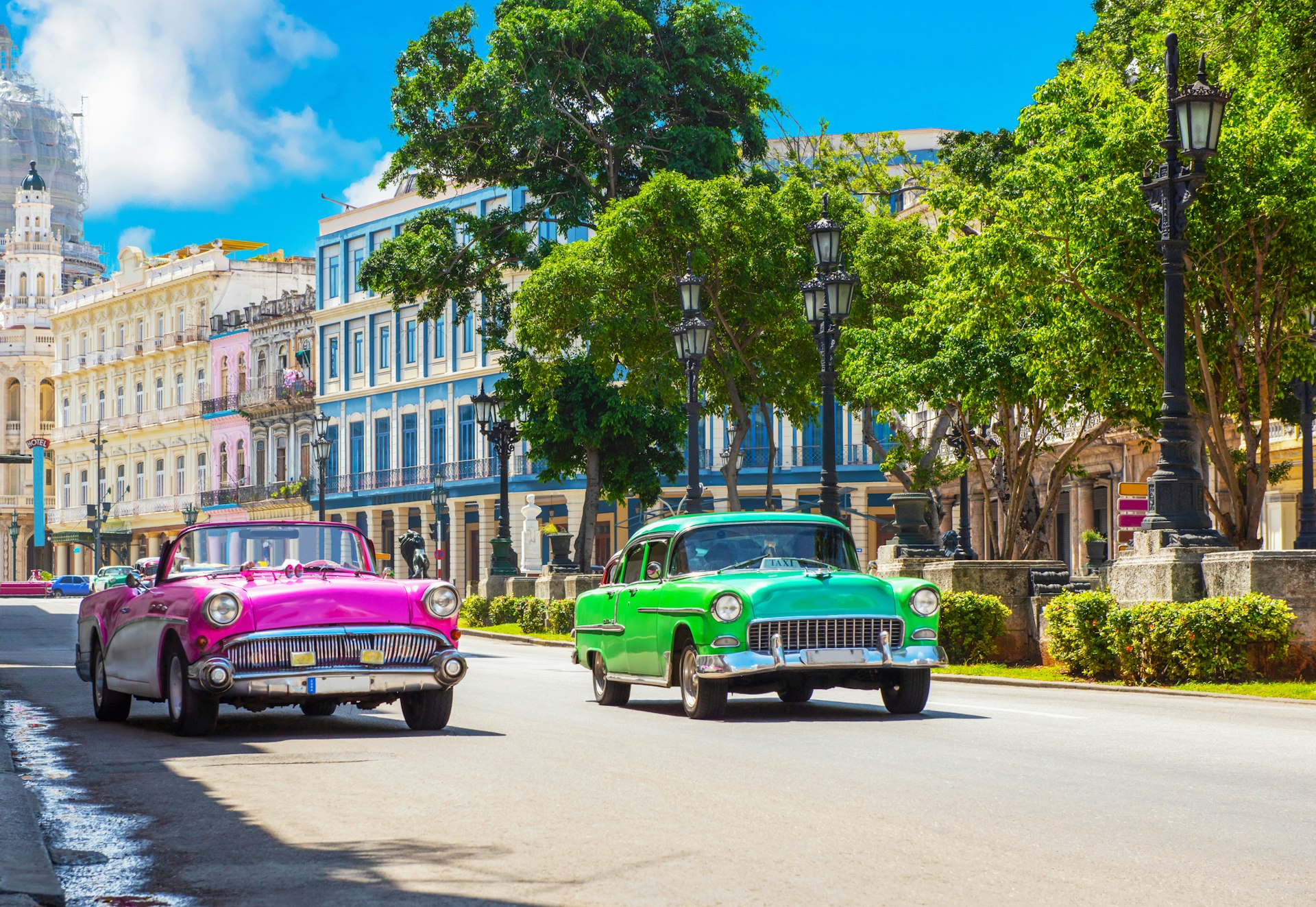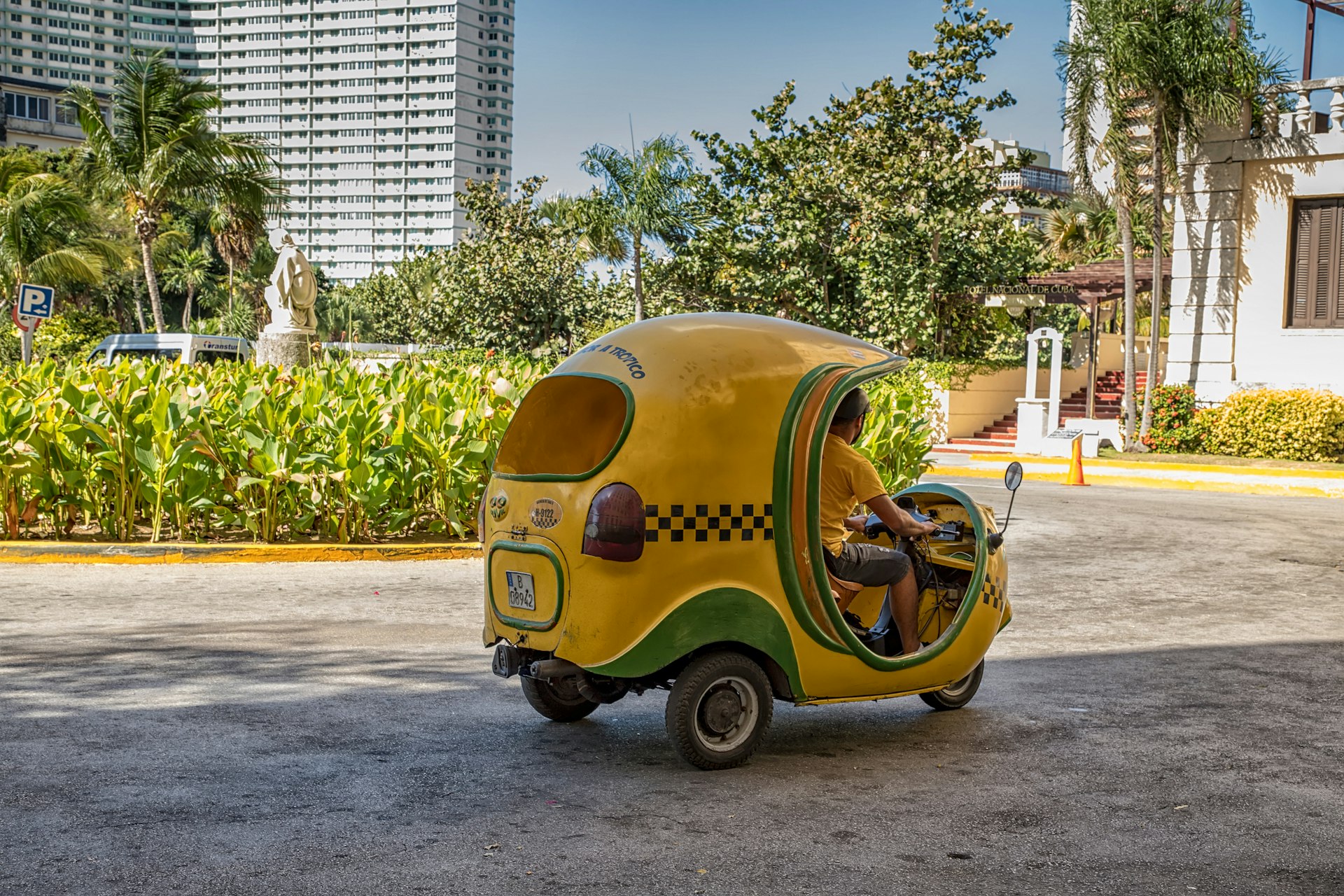
In a city where few people own cars, the residents of Havana are accustomed to getting around on public transportation. But what might be simple for locals isn’t always easy to understand for visitors. Poor signage and idiosyncratic rules can make navigating Havana’s transport system tricky for unversed tourists.
In contrast to other cities of its size, Havana has no metro train system. Instead, the urban area relies mostly on buses and taxis. If you’ve got the energy, the best way to get around is on foot, although there’s a reasonably-priced tourist bus, and taxis are a viable option if you’re heading out to the suburbs. Here’s the lowdown on Havana’s transport options.
Get more travel inspiration, tips and exclusive offers sent straight to your inbox with our weekly newsletter.
Join the locals on a metro bus
Havana’s articulated metro buses, known locally as guas-guas (pronounced “wah-wahs”), run along 17 set routes connecting central Havana with the suburbs. They’re hot, crowded, and used mainly by locals, but curious budget-conscious tourists can give them a try. The hub for many of the routes is Parque de la Fraternidad in Centro Habana. Fares cost in the vicinity of 10 pesos (about US$0.40). Pay on entry and watch your bags.
Smaller minibuses (taxis ruteros) run along additional routes in central Havana, charging slightly higher fares.
 See the sights from the top of a hop-on, hop-off bus in Havana © Lucian Milasan / Shutterstock
See the sights from the top of a hop-on, hop-off bus in Havana © Lucian Milasan / Shutterstock
Get a tour plus transport on the sightseeing bus
Like many big cities, Havana has its own hop-on, hop-off double-decker bus service called the Havana Bus Tour that runs on two main routes throughout the day. The open-topped T1 takes in most of the tourist sights in Centro Habana, Vedado, and Miramar. The single-story T3 runs to the beaches of Playas del Este via the city’s historic forts. Both have their main terminus in Parque Central opposite the Hotel Inglaterra and depart every 20 to 30 minutes. All-day tickets cost the equivalent of around US$10 and must be paid for by credit card (no cash) on entering the bus.
If you’re near the hotel zones, you can hop on the airport bus
State-run company Transtur Havana has introduced a shuttle bus to and from Havana’s José Martí International Airport. If you’re in a hurry or just want to be guaranteed an easy arrival to Havana, pre-book a private transfer online.
If you’d prefer to save cash, you can join a group heading to the hotel zone, although you’ll need to wait (sometimes up to an hour) for enough passengers. The trip between the airport and Parque Central via the hotel zones in Vedado and Playa costs the equivalent of US$10 and must be paid for with a credit card onboard.
Private taxis are cheaper but often lack amenities
Private taxis – invariably Russian Ladas – roam the streets in search of fares or wait at spots a little away from the official taxi ranks. They’re generally cheaper than state-operated taxis but are less luxurious (forget air conditioning and pray that there’s a seatbelt). Foreign currency (ideally euros) is the preferred method of payment – these taxis are cash only. Agree on a fare before you get in.
Cubataxis are quick and comfy
The state-owned taxis operated under the Cubataxi umbrella are usually modern yellow cars with air conditioning and meters that are leased by the government to private drivers. They pick up outside hotels and at taxi ranks, and they cost more than Lada taxis. The bonus? They’re faster and more comfortable than private taxis.
 One way to get around is on a driving tour of Havana in a vintage car © Getty Images / iStockphoto
One way to get around is on a driving tour of Havana in a vintage car © Getty Images / iStockphoto
Sightsee from the antique seats of a Gran Car
Gran Car is a state-run company that offers private city tours in meticulously restored vintage American cars. The eye-catching autos, which range from bright pink Chevrolet Bel Air convertibles to 1940s-era Fords, generally wait in the vicinity of Parque Central and charge the equivalent of US$30 for an hour-long trip around Havana’s main sights.
The drivers double up as guides, although their commentary skills can be hit or miss. That said, they’re hugely popular with tourists. Longer excursions and custom trips can be negotiated with the driver. Most cars fit four passengers, and the fare can be shared among the group.
Old American almendronestake locals on set routes
Primarily used by locals, almendrones (sometimes called máquinas) are shared taxis that motor along fixed routes. They’re usually wheezing old American cars with rattling suspension that squeeze in five or six passengers. Almendrones will stop anywhere along their route to pick up or drop off passengers if they have space. Habaneros use a series of complicated hand signals to indicate to drivers where they want to go. You’ll have to team up with a local if you want to learn the informal sign language.
 You might need to be a little coconuts to get in a Coco taxi © Eduard Valentinov / Shutterstock
You might need to be a little coconuts to get in a Coco taxi © Eduard Valentinov / Shutterstock
Skip the yellow coco taxis
These hard-to-miss, three-wheeled taxis shaped like coconuts and painted yellow were originally designed for the tourist market in the 1990s. More recently, they’ve suffered criticism for their poor safety record and price gouging. You’re better off walking or hailing a real taxi.
Reach the narrow streets of Habana Vieja in a bici-taxi
Three-wheeled bicycle rickshaws ply short inner-city routes too narrow or congested for cars, primarily in Habana Vieja. They charge between 25 and 50 pesos (US$1 to US$2) per ride. Agree on rates before you get in, and expect a bumpy journey.
Head to Havana’s forts on a boat
Havana’s only boat service shuttles passengers across the city’s harbor to Regla or Casablanca (a short walk from the forts), leaving every 15 or 20 minutes from the Emboque de Luz on the southeastern side of Habana Vieja. The fare costs around 10 pesos (US$0.40). A quick bag search is conducted before you get in. Onboard, it’s standing room only, but the trip takes less than 10 minutes. Bicycles are allowed on the boats.
Ride through the capital by bicycle
Several reputable companies, including Ruta Bikes, rent bikes that are good for getting around town. If you’re uncertain of Havana’s geography or the slightly manic road rules, the company also offers a selection of excellent guided tours.
In 2018, Havana inaugurated a pilot bike-sharing scheme called Ha’Bici. Aimed primarily at locals, it currently only operates in Habana Vieja with a limited number of bikes.
 The best way to get around Havana has to be by foot © Getty Images / iStockphoto
The best way to get around Havana has to be by foot © Getty Images / iStockphoto
Stroll the sea drive and walk Havana’s historic core
Havana is a good walking city. Strolling along the 7km-long (4.3 miles) Malecón sea drive is an obligatory city diversion, and much of Habana Vieja’s historic core is pedestrian only. Centro Habana’s tight grid of streets is also best explored on foot. Beware of rutted pavements, baskets being lowered from 4th-floor windows, flying balls, and blistering heat.
Don’t count on driving a rental car in Havana
Renting a car in Havana is not worth the expense or hassle. State-run rental agency Cubacar regularly runs out of vehicles in peak periods, and the paperwork involved can be long-winded and onerous. Despite low car ownership, driving in Havana is not a piece of cake. Roads, particularly in the suburbs, are frequently potholed, and local car owners often drive frenetically.
Accessible transportation in Havana
In comparison to the US or Europe, Havana is not an easy city for wheelchairs, walkers, strollers, and the like. That said, plenty of Cubans live with disabilities and mobility requirements, so getting around is not impossible – just more difficult than you might be used to.
Because most buses are perennially crowded, your best transport option is to organize a modern state-run taxi with a trunk large enough to accommodate a wheelchair or walker. Minivans are rare in Cuba, but it’s worth asking around.
Sidewalks are narrow, especially in Habana Vieja, plus they’re often pockmarked and packed with people. Fortunately, recent improvements have made the pedestrianized section of the old town much smoother.
Making up for the unreliable infrastructure, Habaneros, as a rule, are extremely courteous and friendly, and they will bend over backward to make your stay as smooth and enjoyable as possible.
For more tips and advice, download Lonely Planet’s free accessible travel guide.



